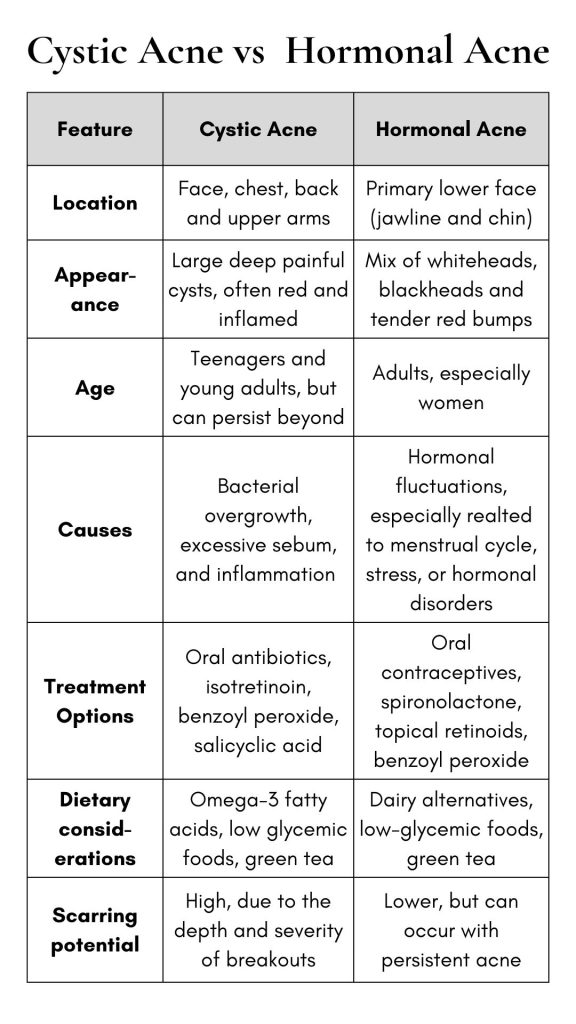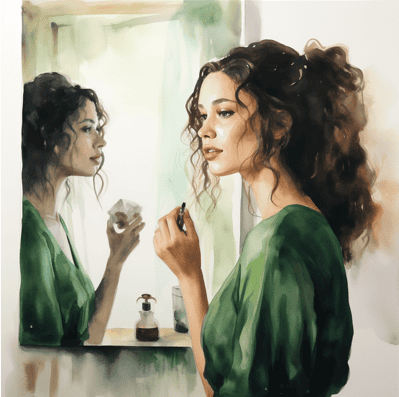
Ever felt like no matter what you do, acne seems to have a mind of its own? Maybe you’re not treating it right, and cystic acne vs hormonal acne have different needs. Whether it’s cystic acne with its deep, painful bumps or the frustrating timing of hormonal acne breakouts, distinguishing between these two types of acne could be the key to unlocking your best skin.
Hi, I’m Hazel
I gave up on skincare after years of issues with acne and sensitive skin.
But after going plant-based, my skin cleared up and even started to glow. Now I help women reveal their natural beauty with simple, delicious plant-based food.
I also used to be a nurse, and love nerding out on nutritional science (high-quality science, that is).

As usual, this post is based on the strongest nutritional evidence I could find with a focus on the simplest, most delicious foods
…because who has time to waste on actions that don’t work?
The quick version:
Cystic acne is a deep, painful form of acne that often results in scarring, driven by infections deep within the skin and excessive bacterial growth. Hormonal acne, on the other hand, typically arises from hormonal fluctuations and presents itself with a combination of whiteheads and tender bumps, mainly around the lower face.
How do I know if my acne is hormonal or cystic?
Are you dealing with cystic acne or hormonal acne? Here’s how to tell:

Cystic Acne
This is serious business.
It’s not just your average pimple; it’s the most severe form of acne. Imagine the deepest, most painful pimples that take weeks to heal.
That’s cystic acne for you.

Hormonal Acne
This type of acne pops up in sync with hormonal imbalances—think periods or stress.
It typically makes its appearance on the lower face, showing up as both painful bumps and those pesky whiteheads.
Recognising what you’re dealing with is the first step towards clear, healthy skin. Let’s dive deeper into what makes these two acne villains tick in the next sections.
Identifying the Main Differences
The devil is in the details when distinguishing between cystic acne and hormonal acne. Here’s how their characteristics stack up:

Location
Cystic acne can appear almost anywhere—your face, back, even your upper arms—but it loves to go deep.
Hormonal acne prefers the real estate of your lower face. Jawline and chin? Prime spots.
Appearance
Cystic pimples are the big, bad guys. Red, swollen, and lurking under your skin, they don’t pop easily (and you shouldn’t try!).
On the other hand, hormonal acne can range from small blackheads to medium-sized, tender red bumps.
Spotting these differences can be your ‘aha’ moment, helping you tailor your approach for the type of breakouts you’re actually facing.
You may also like:
Clearing Up Menopausal Acne: How to Calm Your Acne Flare-Ups
Causes and Triggers
Why exactly does your skin rebel with acne? Both cystic and hormonal acne have their triggers, but their origins are quite distinct:
Cystic Acne
Think of it as a perfect storm inside your skin.
A mix of dead skin cells, excess oil, and propionibacterium acnes bacteria clogs your pores deep down, causing big, painful, and persistent pimples.
Hormonal Acne
This type follows the rhythm of your hormones.
Changes in hormone levels—like those during your menstrual cycle—can increase oil production. More oil equals more opportunities for pores to get clogged and inflamed.
Understanding these triggers is crucial, not just for treating your current breakouts but for preventing future ones. It’s about getting to know your skin and the underlying causes that lead you to search for solutions like ‘cystic acne vs. hormonal acne’. Next up, let’s look at how you can treat each type effectively.
Dietary Approaches to Treating Acne

Your diet plays a significant role in managing acne, influencing everything from hormonal changes to sebum production.
It should be your first priority in skincare (and self-care).
Here’s how you can adjust your diet to potentially reduce the severity of both cystic and hormonal acne:
Dietary Tips for All Acne Types
- Green Tea: Rich in antioxidants, green tea can boost your immune system and may help reduce inflammation associated with severe acne. Its anti-inflammatory properties are also useful in calming the sebaceous glands, which can reduce the overproduction of sebum.
- Avoid Poor Diet Choices: High-glycemic foods and a poor diet can exacerbate acne. Opt for whole grains and plenty of vegetables to keep your skin clearer.

Recommendations for Cystic Acne
- Omega-3 Fatty Acids: Foods high in omega-3s, such as flaxseeds, chia seeds, and walnuts, can help regulate inflammation levels in the body, potentially reducing the severity of breakouts.
- Plant-Based Probiotics: Consuming fermented plant-based foods like sauerkraut, kimchi, and tempeh can help maintain healthy gut flora, supporting overall skin health and balancing bacteria levels, which is crucial given the side effects of long-term antibiotic use.
You’ll also love:
The Simplest Acne Free Diet Plan: 30 Days Clearer Skin
Dietary Changes for Hormonal Acne
- Dairy Alternatives: Swapping dairy for plant-based alternatives can help manage hormonal changes linked to acne. Dairy can sometimes stimulate sebum production, so using alternatives like almond, soy, or oat milk might help in reducing breakouts.
- Low Glycemic Diet: Since hormonal acne is often exacerbated by spikes in blood sugar which can increase oil production, focusing on a low glycemic diet can help stabilise hormone levels and reduce acne.
You may also like:
Herbs for Hormonal Acne: Transform Your Skin
By making these lifestyle changes and adjusting your diet, you may not only see improvements in your skin but also avoid some of the side effects associated with conventional acne treatments. These dietary approaches provide a holistic way to address both the internal and external factors that contribute to acne.
Acne Treatments
Cystic Acne Treatments
Cystic acne can be particularly stubborn and severe, requiring strong treatments:
- Oral Antibiotics: Useful for reducing the infection and inflammation that characterise this deep-set acne.
- Isotretinoin: A potent option for those with persistent cystic acne, often considered when other treatments fail.
- Benzoyl Peroxide and Salicylic Acid: These topical treatments are essential for managing bacteria and keeping pores clear.
- Laser Treatments and Chemical Peels: These procedures can help reduce scarring and improve skin texture, beneficial for the deep scars often left by cystic acne.
Skincare for Cystic Acne
- Salicylic Acid: Helps to deep-clean pores.
- Tea Tree Oil: Offers natural antibacterial properties, helpful in reducing bacteria and inflammation.
Hormonal Acne Treatments
Hormonal acne requires a different approach, focusing on hormonal balance:
- Oral Contraceptives: These help regulate menstrual cycles and can effectively reduce acne by balancing hormone levels.
- Spironolactone: Targets hormonal fluctuations by decreasing androgen levels, which can lead to reduced oil production and fewer breakouts.
- Azelaic Acid: Excellent for reducing inflammation and clearing bacteria that contribute to acne.
Skincare for Hormonal Acne
- Niacinamide: Useful in products for controlling oil production, crucial for treating hormonal acne.
- Regular Cleansing and Topical Retinoids: Helps turn over dead skin cells and prevent them from building up, keeping the skin clear.
By tailoring your treatment and skincare approach to the specific type of acne you’re battling—whether cystic or hormonal—you enhance your chances of improving your skin’s health and appearance. Each type of acne has its unique challenges, but with the right strategies, you can achieve clearer, healthier skin.
Monitoring Progress
The journey to clear skin isn’t always straightforward. It’s important to keep an eye on how your skin responds to your skincare regimen.
Here’s what to consider:
- Track Changes: Keep a skin diary or take regular photos to monitor your skin’s response to treatments. Noticing patterns can help you understand what works and what doesn’t.
- Adjust Treatments: If you don’t see improvement after several weeks, or if your skin reacts poorly, consult your dermatologist. You might need to adjust your treatment plan or try alternative treatment options.
Cystic acne vs Hormonal acne
Navigating the complexities of cystic acne vs hormonal acne can be challenging, but with the right knowledge and approach, managing these conditions becomes much more attainable. By identifying the type of acne you’re dealing with and adopting tailored dietary and skincare strategies, you can significantly enhance your skin’s health and appearance.
References
Most references below will link to the original peer-reviewed study itself. However, sometimes I will link to a video over at NutritionFacts.org instead, which is by far the single best resource of brutally transparent nutritional evidence you will ever see. Dr Greger tells a great story about the realities of the science and if I think you will benefit more from one of his videos, the link will take you there instead.
Happy nerding!
- Elsaie ML. Hormonal treatment of acne vulgaris: an update. Clin Cosmet Investig Dermatol. 2016;9:241-248. Published 2016 Sep 2. doi:10.2147/CCID.S114830
- Durairaj, Akiladevi & Keyan, Karthi & Shanmugam, Anandakumar. (2023). Cystic acne treatment: A comprehensive review. Medicine Advances. 1. 10.1002/med4.43.